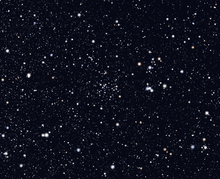NGC 6811
| NGC 6811 | |
|---|---|
 | |
| Observation data (2000.0 epoch) | |
| Constellation | Cygnus |
| Right ascension | 19h 37m 17s[1] |
| Declination | +46° 23′ 18″ |
| Distance | 3600 ly[2] (1107 pc[2]) |
| Apparent magnitude (V) | 6.8 |
| Apparent dimensions (V) | 13' |
| Physical characteristics | |
NGC 6811 is an open cluster in the constellation of Cygnus,[3] near the constellation of Lyra.[4] It has an angular size half that of the full Moon and includes about 1000 stars[5] of roughly similar magnitude.[3][6] It has also been called "The Hole in the Cluster" because of its dark center.[6][7]
Features
NGC 6811 lies far away from the galactic plane, a feature it shares with many other old open clusters.[6] It is 1107 ± 90 parsecs distant,[2][8] 14–20 light years across,[6][9] and has a total luminosity of 2100 suns.[9] Approximately 1.00 ± 0.17 billion years old, it probably contained some 6000 stars at birth,[5] but gravitational interactions and stellar evolution have since reduced the number to 1000.[5] The spectral types of most of its stars range from mid-F to early-K, with surface temperatures relatively similar to the Sun's;[4] the rest include A2-types,[9] several O-types, and more than 100 B-types.[5] Sixteen stars have been observed to vary in brightness, twelve of which are Delta Scuti variables.[10] Its Trumpler classification is III 1r—it is "a rich cluster with equally bright stars with no noticeable central concentration".[6] The stars do, however, have an unusual (if not concentrated) distribution, with an apparent corona surrounding the core, leaving the impression of a hole.[6]
Observation
NGC 6811 was first observed by John Herschel in 1829 and was added to his General Catalogue of Nebulae and Clusters in 1864.[11] The cluster has been the subject of study by the Kepler mission, with the aim of characterizing its stars' rotation rate, age, and distance to help the hunt for exoplanets.[4]
NGC 6811 is best observed from Earth in the Northern Hemisphere in summer. In these conditions it lies close to the zenith during the night, northeast of Delta Cygni.[3] It is considered an aesthetically pleasant object for amateur astronomers, even if the brightest members are just 10th magnitude objects. It appears as a hazy patch in 10x binoculars, but it is best seen at around 70x with a moderate-aperture telescope.[9] It has been described by amateur astronomers as a "smoke ring of stars" or "a jeweled mask a woman might wear at a masquerade ball".[6]
Planets
Two planets (Kepler 66b and Kepler 67b), orbiting Sun-like stars in the NGC 6811 cluster, have been discovered by the Kepler mission using the transit method.[2] Both planets are smaller than Neptune and are both the first sub-Jupiter planets and the first transiting planets discovered orbiting stars within an open cluster.[2] Given that the age and distance of the cluster have been accurately measured, the two planets are among the few of which age and distance are accurately known.[12] This finding suggests that the frequency of planets in clusters is similar to that in stars not belonging to clusters or associations[2][12] and that planets can form and survive in environments more crowded and violent than the one of our own Sun.[5]

See also
References
- ↑ "NGC 6811". SIMBAD. Centre de données astronomiques de Strasbourg. Retrieved 11 May 2013.
- 1 2 3 4 5 6 Meibom, S. R.; Torres, G.; Fressin, F.; Latham, D. W.; Rowe, J. F.; Ciardi, D. R.; Bryson, S. T.; Rogers, L. A.; Henze, C. E.; Janes, K.; Barnes, S. A.; Marcy, G. W.; Isaacson, H.; Fischer, D. A.; Howell, S. B.; Horch, E. P.; Jenkins, J. M.; Schuler, S. C.; Crepp, J. (2013). "The same frequency of planets inside and outside open clusters of stars". Nature. 499 (7456): 55–58. arXiv:1307.5842. Bibcode:2013Natur.499...55M. doi:10.1038/nature12279. PMID 23803764.
- 1 2 3 Ayiomamitis, Anthony. "NGC 6811". Astronomy Magazine. Kalmach Publishing Co. Retrieved 9 July 2013.
- 1 2 3 Meibom, S. R.; Barnes, S. A.; Latham, D. W.; Batalha, N.; Borucki, W. J.; Koch, D. G.; Basri, G.; Walkowicz, L. M.; Janes, K. A.; Jenkins, J.; Van Cleve, J.; Haas, M. R.; Bryson, S. T.; Dupree, A. K.; Furesz, G.; Szentgyorgyi, A. H.; Buchhave, L. A.; Clarke, B. D.; Twicken, J. D.; Quintana, E. V. (2011). "The Kepler Cluster Study: Stellar Rotation in Ngc 6811". The Astrophysical Journal. 733: L9. arXiv:1104.2912. Bibcode:2011ApJ...733L...9M. doi:10.1088/2041-8205/733/1/L9.
- 1 2 3 4 5 Balouchi, Shari. "Crowded Clusters Can Host Planets, Too". Sky and Telescope. Archived from the original on 10 July 2013. Retrieved 9 July 2013.
- 1 2 3 4 5 6 7 Stephen James O'Meara (30 June 2011). Deep-Sky Companions: The Secret Deep. Cambridge University Press. pp. 389–. ISBN 978-1-139-50007-4. Retrieved 9 July 2013.
- ↑ L. Phil Simpson (2012). Guidebook to the Constellations. Springer. pp. 505–. ISBN 978-1-4419-6941-5. Retrieved 9 July 2013.
- ↑ Janes, K.; Barnes, S. A.; Meibom, S. R.; Hoq, S. (2013). "Ngc 6811: An Intermediate-Age Cluster in the Kepler Field". The Astronomical Journal. 145: 7. Bibcode:2013AJ....145....7J. doi:10.1088/0004-6256/145/1/7.
- 1 2 3 4 Craig Crossen; Gerald Rhemann (27 January 2004). Sky Vistas: Astronomy for Binoculars and Richest-Field Telescopes. Springer. pp. 67–. ISBN 978-3-211-00851-5. Retrieved 9 July 2013.
- ↑ Luo, Y. P.; Zhang, X. B.; Luo, C. Q.; Deng, L. C.; Luo, Z. Q. (2009). "Variable stars in the open cluster NGC 6811". New Astronomy. 14 (6): 584. arXiv:1410.2178. Bibcode:2009NewA...14..584L. doi:10.1016/j.newast.2009.02.005.
- ↑ "The NGC/IC Project". Results for NGC 6811. Retrieved 11 May 2013.
- 1 2 "First Transiting Planets in a Star Cluster Discovered". Harvard-Smithsonian Center for Astrophysics. Retrieved 9 July 2013.